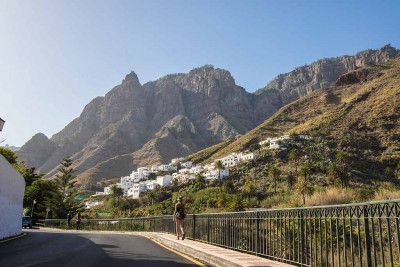Agaete Valley

Agaete Valley leaves no one indifferent ... the winding road that leads into this oasis at the foot of the Tamadaba Natural Park gradually reveals hypnotizing views among the palm trees. Entering Agaete Valley is like entering a paradise full of farms, whitewashed houses, tropical and orange trees, vines and coffee plantations. And all this surrounded by immense pointed and velvety crags where lush canarian pines belonging to the Tamadaba Natural Reserve can be seen in their profiles. Agaete valley is a color festival for the eyes and walking through it is a meditation in itself ... It is thanks to its fertile volcanic soil that all these tropical crops are possible. Here you can come to taste the coffee that is produced on a small scale.
Agaete Valley leaves no one indifferent ... the winding road that leads into this oasis at the foot of the Tamadaba Natural Park gradually reveals hypnotizing views among the palm trees. Entering Agaete Valley is like entering a paradise full of farms, whitewashed houses, tropical and orange trees, vines and coffee plantations. And all this surrounded by immense pointed and velvety crags where lush canarian pines belonging to the Tamadaba Natural Reserve can be seen in their profiles. Agaete valley is a color festival for the eyes and walking through it is a meditation in itself ... It is thanks to its fertile volcanic soil that all these tropical crops are possible. Here you can come to taste the coffee that is produced on a small scale. This is precisely the only place in Europe where it is cultivated and the specialty is entirely Arabiga; precisely thanks to the special weather conditions and its rich soil, which even provides groundwater for plantations. In fact, traditional methods are used here to treat coffee and the harvesting of the cherries from the coffee plantations is done manually. You can visit these farms in the neighborhood or hamlet of San Pedro, if you want to taste such precious coffee and even the wine that is produced there, for example, in Finca La Laja.
Some of the most beautiful hiking trails start from the valley. It is possible to go up to Tamadaba Natural Park and even reach Artenara. On the way up there is Roque Bermejo, whose reddish color and the type of soil make it very striking. Right there you will walk in front of the aboriginal town of Virbique or Visbique, which can be seen from the same path that goes up and where you can see the ancient dwelling caves and barns carved out of the rock. The locals also lived and still live in caves in the town of El Hornillo, another place with privileged views and a nice refuge to eat.
Possibly, Gran Canaria colonizers discovered also the great wealth that Agaete Valley was hiding and that is why they decided to install in this area one of the most important sugar mills on the island. Thanks to this industry Agaete had a good economic future for a long time. This industry had its comings and goings until in the middle of the 20th century the banana plantations were replacing this type of cultivation and now there are hardly any vestiges of the ruins that were found some 15 years ago from the old sugar mill facilities.
Not only the Spanish colonizers saw the wealth of this valley, but also Agatha Christie knew how to appreciate its charm thanks to the medicinal waters of the old Los Berrazales spa. In Gran Canaria, Christie discovered the perfect climate and the spas in the area, such as Los Berrazales and Azuaje, called a large volume of wellness tourists in their golden days.The valley is only 15 minutes from the beach. And it is worth getting lost in it, walking it, breathing it, observing it from different places until you fall in love with this place ...

